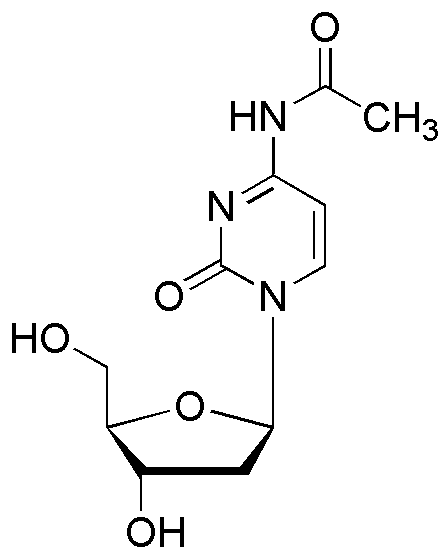N4-Acetyl-2'-deoxycytidine is widely utilized in research focused on:
- Antiviral Research: This compound is often studied for its potential in developing antiviral therapies, particularly against viruses like HIV, due to its ability to inhibit viral replication.
- DNA Synthesis: It serves as a building block in the synthesis of modified nucleotides, which are crucial for creating DNA strands in genetic engineering and synthetic biology applications.
- Epigenetics: Researchers use it to explore epigenetic modifications, as it can influence gene expression by altering DNA methylation patterns.
- Pharmaceutical Development: The compound is investigated for its role in formulating new drugs, especially in cancer therapy, where it may enhance the efficacy of existing treatments.
- Biotechnology: It is applied in various biotechnological processes, including the development of diagnostic tools and therapeutic agents, thanks to its versatility in modifying nucleic acids.
General Information
Properties
Safety and Regulations
Applications
N4-Acetyl-2'-deoxycytidine is widely utilized in research focused on:
- Antiviral Research: This compound is often studied for its potential in developing antiviral therapies, particularly against viruses like HIV, due to its ability to inhibit viral replication.
- DNA Synthesis: It serves as a building block in the synthesis of modified nucleotides, which are crucial for creating DNA strands in genetic engineering and synthetic biology applications.
- Epigenetics: Researchers use it to explore epigenetic modifications, as it can influence gene expression by altering DNA methylation patterns.
- Pharmaceutical Development: The compound is investigated for its role in formulating new drugs, especially in cancer therapy, where it may enhance the efficacy of existing treatments.
- Biotechnology: It is applied in various biotechnological processes, including the development of diagnostic tools and therapeutic agents, thanks to its versatility in modifying nucleic acids.
Documents
Safety Data Sheets (SDS)
The SDS provides comprehensive safety information on handling, storage, and disposal of the product.
Product Specification (PS)
The PS provides a comprehensive breakdown of the product’s properties, including chemical composition, physical state, purity, and storage requirements. It also details acceptable quality ranges and the product's intended applications.
Certificates of Analysis (COA)
Search for Certificates of Analysis (COA) by entering the products Lot Number. Lot and Batch Numbers can be found on a product’s label following the words ‘Lot’ or ‘Batch’.
*Catalog Number
*Lot Number
Certificates Of Origin (COO)
This COO confirms the country where the product was manufactured, and also details the materials and components used in it and whether it is derived from natural, synthetic, or other specific sources. This certificate may be required for customs, trade, and regulatory compliance.
*Catalog Number
*Lot Number
Safety Data Sheets (SDS)
The SDS provides comprehensive safety information on handling, storage, and disposal of the product.
DownloadProduct Specification (PS)
The PS provides a comprehensive breakdown of the product’s properties, including chemical composition, physical state, purity, and storage requirements. It also details acceptable quality ranges and the product's intended applications.
DownloadCertificates of Analysis (COA)
Search for Certificates of Analysis (COA) by entering the products Lot Number. Lot and Batch Numbers can be found on a product’s label following the words ‘Lot’ or ‘Batch’.
*Catalog Number
*Lot Number
Certificates Of Origin (COO)
This COO confirms the country where the product was manufactured, and also details the materials and components used in it and whether it is derived from natural, synthetic, or other specific sources. This certificate may be required for customs, trade, and regulatory compliance.


